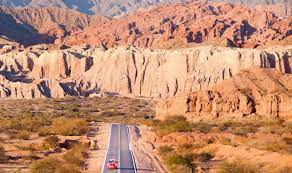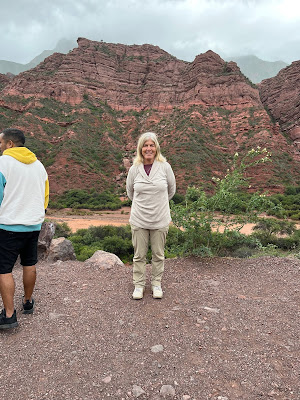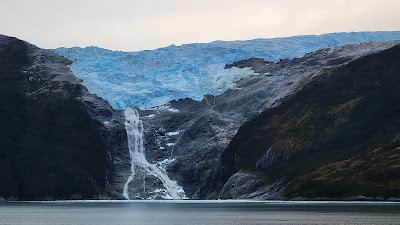There are a few cultural things that mystify me about Argentinos besides their “tranquilo” attitude. They patiently stand in long, unnecessary lines. For example, they line up at bus stops, but some people sit on benches and others walk in from the other direction when the bus arrives. No one seems concerned about line cutting; I’m not sure they even have a concept of it.
They also stand patiently in long lines to take their pictures at tourist sites and they don’t just stand smiling in the pictures. They strike extravagant or sultry poses. In my neighborhood of San Telmo in Buenos Aires there was a full size statue of Mafalda, a famous cartoon character, sitting on a bench. Every evening and all day on Saturdays and Sundays, people stood in line to take their picture sitting on the bench next to her.
At the summit on our drive to La Gran Salida, they stood in line to take their picture next to the altitude sign. I even stood in line with them, something I rarely do voluntarily, but I was going to have to stand around waiting anyway for everyone to take a picture, so …
.jpg) |
| Hard to see but these are lines of people to take pictures in a wide open space |
Another apparently cultural thing: the Argentinos applaud when their plane lands, something I have not experienced since flying to Israel in the 1970’s. They also applaud politely when the tour guide introduces himself, again when he introduces the driver, and again at the end of each tour separately for the guide and driver.
I have met some interesting people, Argentine and otherwise, on my various excursions. On the Humahuaca bus I sat next to a very nice young Frenchman who was on his way to Bolivia to climb mountains. He had all his things with him and a bus ticket for 2:30 AM that night but ended up staying in Humahuaca to try his luck at the bus terminal there because he didn’t believe he would make it back in time to catch his bus. After our seven hours of delays, he was probably right.
The next day I sat next to a very nice young Argentine man who was on vacation from Buenos Aires. As we drove through the beautiful Quebrada, he told me it reminded him of the Grand Canyon. He took out his phone and showed me a picture of himself there. I still say it reminds me more of Utah, but I can’t argue with him. I had told him that I could understand him if he spoke a little slower. The usual conversational speech of most Argentinos is a little too fast for me to decipher. He obligingly slowed his speech waaay down. Where… are…you… from? But it worked. We conversed at length.
Sports turns out to be an instant identifier for people you meet when traveling. I talked to a couple around my age who were vacationing in Salta. I asked where they were from and they said, Rosario, about 300 north of Buenos Aires. I know, I said, it is where Messi is from. (I had been listening to a podcast in Spanish about Messi while walking to and from school or I would never had known where he was from.) When I was talking to the young Frenchman, he asked where I was from. California, I said. Los Angeles, San Francisco? he asked. Sacramento, I said, it’s near San Francisco. I know, he said, I am a fan of the NBA.
One day during my month in Buenos Aires, I was sitting in my local park in San Telmo reading on my kindle when a man sitting near me asked me the time. I told him. He then said, it sounds like you have an American accent and started talking to me in English. He asked what I was reading, and then asked if I had read William Faulkner. Not my favorite, I replied, although by coincidence I had recently reread As I Lay Dying. He then proceeded to lecture me on how great Faulkner is and what an influence he was on other writers. Have you read One Hundred Years of Solitude, he asked. Twice, I replied. Well, he said, Faulkner had a big influence on Gabriel Garcia Marquez. Then he discussed sections of As I Lay Dying in detail, and somehow he moved on to Italian history which he lectured me on as well. The man appeared to be older than me and was rather shabbily dressed. I would have believed that he was one of the beggars in the park. But when I asked him how he spoke English so well, it turns out he is an artist and had a gallery in New York for years. He couldn’t describe his art, so he gave me his name and told me to Google him. I did and quickly found and read a New York Times article about him.
My walking tour in Salta was disappointing, but I ended up talking in English to a woman from Russia who lives in Germany. She has a PhD in some esoteric subject connected to social philosophy. What is that? I asked. Have you read Hannah Arendt? she asked. By coincidence, I had recently reread one and a half of her books. She seems a bit dated to me, I said. Of course, she replied, she was writing about a specific type of totalitarianism in the 1930’s. We then proceeded to have a long discussion about the banality of evil and how “ordinary” people can do such horrible things.
I do meet such interesting people when I travel and somehow, I rarely have conversations with strangers about Faulkner or Hannah Arendt in Sacramento.




.jpg)
















.JPG)

.jpg)










.jpg)